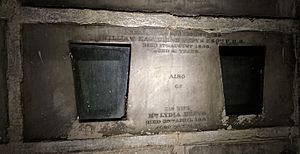William Haseldine Pepys facts for kids
William Haseldine Pepys (born March 23, 1775 – died August 17, 1856) was an English scientist. He helped start many important scientific groups. Pepys made big contributions to chemistry and physics in the early 1800s. You might see his name spelled "William Hasledine Pepys" too, as both spellings were used when he was alive.
Contents
Early Life and Beginnings
William Pepys was born in London. His father, also named William Pepys, made knives and tools for doctors. Young William learned this trade from his father, starting his apprenticeship in 1789. This means he worked for his father to learn the skills.
By 1796, he became a full member of the Worshipful Company of Cutlers, a group for people who made cutting tools in London. William Pepys was also part of a group of Quakers and other religious people in London. Because of their beliefs, they were often kept out of mainstream politics and social life. This encouraged them to focus on making progress in useful skills, wealth, knowledge, and talent.
Founding Scientific Societies
Pepys was very active in starting new scientific groups.
- In 1796, he helped create the Askesian Society.
- In 1799, a meeting was held at his own laboratory. Here, he and others, including William Allen, founded the British Mineralogical Society. This group was made up of chemists, doctors, and business owners who worked with things like iron or scientific instruments. These businesses were changing fast because of new technology. The British Mineralogical Society was an early version of the important Geological Society of London.
In 1806, Pepys was also a key person in starting the London Institution. He was one of its first managers.
Amazing Inventions and Discoveries
William Pepys was a clever inventor and researcher.
- In 1798, he worked on machines to make soda water.
- He also found ways to use mercury for electrical equipment.
- He invented the mercury gasometer, a device to measure gases, using tubes coated with India rubber.
Working with Electricity
Pepys studied the new discovery of Voltaic electricity. His 'Voltaic coil' was special because it had only two plates, but they were very large. This made it great for studying how electricity and magnets work together. His friend, the famous scientist Humphry Davy, used Pepys's coil in his own research.
After his father passed away in 1805, Pepys expanded the family business. He started making instruments for scientific studies. He used a process called electrolysis, which uses electricity to cause chemical changes. He even tried to melt platinum using his very large batteries! In 1805, he made platinum fruit knives. He gave one to Sir Joseph Banks and asked him to give a pair to King George III.
In 1807, Pepys invented a type of eudiometer, a tool used to measure gases.
Becoming a Royal Society Fellow
In 1808, William Pepys was elected to the Royal Society, a very prestigious scientific group. By 1815, he was a Fellow of the Royal Society. In 1808 and 1809, he helped raise money for a "great battery" that was installed at the Royal Institution.
By 1815, Pepys used an electric current to heat iron with diamond. This experiment created steel and proved that diamond is a form of carbon. This was a very important discovery!
Working with William Allen
Pepys and his close friend William Allen worked together on many projects. They studied:
- What makes up carbon dioxide.
- How dense ammonia gas is.
- How humans, animals, and plants breathe and use chemicals.
Their research was very successful, largely because of the clever equipment Pepys invented and designed.
Later Life and Leadership
Pepys was a leader in many organizations.
- He was active in managing the Royal Institution of Great Britain and was its vice-president in 1816.
- He was the honorary secretary of the London Institution from 1821 to 1824.
- He was Master of the Worshipful Company of Cutlers in 1822 and 1828.
- He became the Treasurer and Vice-President of the Geological Society.
Besides making surgical instruments, Pepys also took on leadership roles in other businesses. He was a director of the Imperial Continental Gas Association, which brought gas lighting to cities across Europe. He also directed the General Steam Navigation Company, which used steam-powered ships for regular passenger and cargo services to European ports.
Pepys married Lydia Walton in 1815, and they had several children. He passed away at his home in Kensington.
He is buried next to his wife Lydia in the Terrace Catacombs at Highgate Cemetery.


